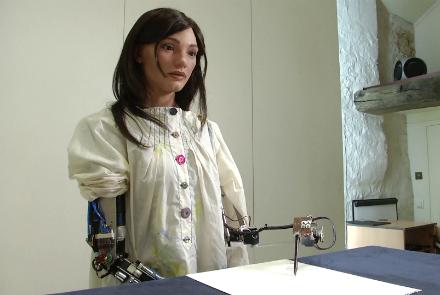Works by a robotic artist have fetched over $1 million USD at the android's debut show, said its creator.
Robotic artist Ai-Da's inaugural exhibit at the University of Oxford questions the ethics of artificial intelligence and what it means to be human.
Art and imagination are often considered to be exclusively human traits, but now an artificially intelligent robot, named “Ai-Da” - has been coded to be created.
And “her” work now appears to be storming the art world.
According to Ai-Da’s creator, gallery director Aiden Meller, “her” artworks have fetched one million British pounds (approx. $1.27 million USD) at her debut show.
“This first show is a sell-out show, it's been an incredibly successful show, over a million pounds worth of work sold,” said Meller.
Ai-Da is claimed to be the world's first ultra-realistic AI robot artist.
She’s named after Ada Lovelace, a 19th-century countess, thought to be the world’s first computer programmer.
The cutting-edge robot was created in collaboration with robotic creators Engineered Arts, with AI algorithms created by experts at the University of Oxford.
Ai-Da can “see” with the help of two cameras, one in each eye, they're connected to a computer vision system which is then interrogated by an AI algorithm.
That means she’s able to do portraits of people that stand in front of her.
She can also draw famous faces if engineers upload a picture, that's then similarly interrogated by the AI algorithm.
The result is not a photorealistic drawing, instead, her unique work is based on cubism, dashed lines defining a human face. The algorithm means each artwork is unique and won't be repeated by the AI.
Ai-Da's pencil is attached to a 500-year-old block of wood - a nod to Renaissance artist Leonardo da Vinci, who died 500 years ago this year.
Ai-Da can draw, but she cannot paint... yet. But they have used coordinates from her drawings to produce paintings and sculptures.
The robot artist's debut exhibit, named "Unsecured Futures", opened at the University of Oxford's Barn Gallery earlier this month.
It includes a combination of sketches of famous figures, including Da Vinci and Alan Turing, paintings and even some self-portraits, a 3D digitally rendered scan.
Meller says they hope to provoke a discussion about the future of artificial intelligence.
"The whole point of this project is to engage audiences to question where future technologies are going," he says.
"The advances that we're going through now with AI and biotechnology and transhumanism are going at an unbelievable pace, ethics is sadly lacking behind gravely and as a result of that we have created Ai-Da to be a voice to engage questions about where future technologies are going."
Art critics might sniff, but Meller says she's a product of her time, just like any artist.
“All artists, the overall time had one actual job and goal and that was to reflect the society they were in,” he said.
“Leonardo (da Vinci) reflected the Renaissance at the time, Andy Warhol, in the 60s, reflected manufacturing and the rise of consumerism.
“The modern artists today, maybe Damien Hirst, was the excesses of the 90s. Ai Weiwei about the political situation in China. Ai-Da reflecting the technological uses that we're using today,” he added.
Ai-Da's debut show at the University of Oxford's Barn Gallery is set to run till 6 July. Meller says they're busy planning her next art adventure.

